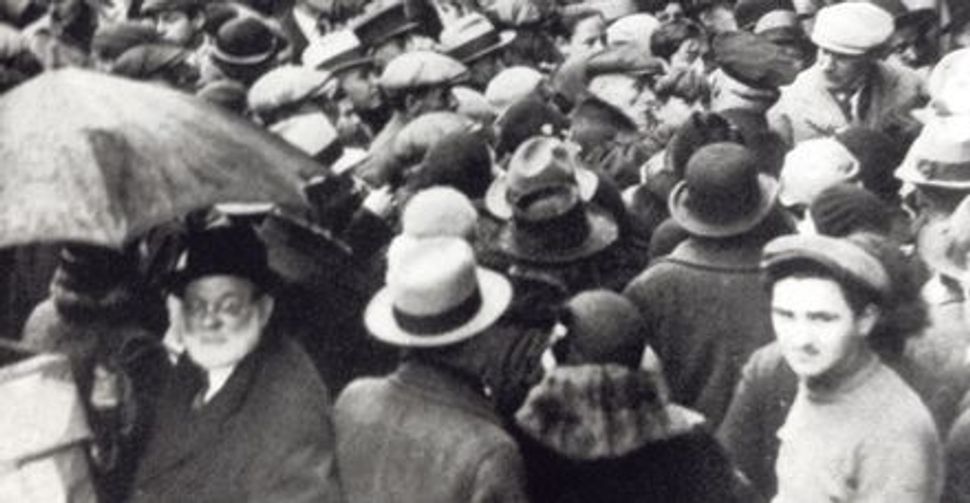Should Israel Have Gone With Yiddish?

Image by Forward ASsociation
Murray Lefkowitz of Merion Station, Pa., writes a letter stating his opinion that it “may have been an unfortunate choice” that Hebrew became the language of the state of Israel, since “Yiddish was the more common tongue for almost all Jews prior to 1948.”
The claim that Yiddish, not Hebrew, was the real national language of modern Jewry was voiced repeatedly in the late 19th and 20th centuries by ideological Yiddishists who, even if not anti-Zionist (and the great majority of them were), contended that Zionism should have adopted Yiddish as the language of a Jewish state in Palestine. Hebrew, they argued, was the property of an educated Jewish elite; Yiddish belonged to the Jewish masses on which Zionism turned its back.

Jargoning Crowd: Statistics of worldwide Yiddish speakers included emigrants from Eastern Europe on New York?s Lower East Side. Image by Forward ASsociation
Yet, quite apart from the incalculable religious and cultural significance of Hebrew in Jewish history as opposed to the more restricted importance of Yiddish, is it really true that most, let alone “almost all,” Jews spoke Yiddish prior to the creation of the State of Israel, in 1948? Or to put the question more fairly, since by 1948 millions of Yiddish speakers had died in the Holocaust, was it the language of most Jews in 1939, when World War II broke out?
If one were to go by the reference books, the answer is yes. According to both Encyclopedia Judaica and the Hebrew Entsiklopediya Ivrit, there were more than 11 million Yiddish speakers in the world in 1939 out of an estimated 16 million Jews. But when one considers where this figure comes from, it can hardly be taken seriously. It is not based on actual statistics of how many Jews in the world spoke Yiddish in 1939 as their first language, how many could speak it but no longer used it in their homes or daily lives, how many could understand it but not speak it, how many could understand it only partially, etc. — because no such statistics exist. It was arrived at by taking the number of Jews living in the traditionally Yiddish-speaking areas of Eastern Europe in 1939 and adding to them their descendants who had emigrated elsewhere, primarily to the United States, and these descendants’ offspring. It thus includes some 3,250,000 Jews living in Poland, 2,800,000 in the Soviet Union, 850,000 in Romania, 250,000 in the Baltic states, 4,750,000 in the United States and several hundred thousand more in countries like Great Britain, Canada and Argentina.
A realistic assessment must be, however, that a large number of these Jews were, by 1939, speaking other languages as their first ones and that many either could no longer speak Yiddish at all or spoke it only haltingly. This was obviously true in the United States, where the grandchildren of Eastern European immigrants were raised entirely in English and rarely knew any Yiddish to speak of. But it was also, though to a lesser extent, true in Eastern Europe itself, where, for the previous two or three generations, cultural assimilation had been steadily reducing the percentage of native Yiddish speakers. For example, a Soviet census taken in 1926 showed only 72.6% of Soviet Jews listing Yiddish as their mother tongue, and this number, too, was dropping rapidly. In Ukraine, where more than half of Soviet Jewry lived, only 49% of urban Jews in the age bracket 0–4 was being brought up in Yiddish, as opposed to 77% raised in it in the age bracket 50–54. (The percentages were higher in villages and small towns, but these were losing population to the cities all the time.)
If this was the situation of Yiddish in 1926, it could only have deteriorated further by 1939 — and the Soviet Union, where the Communist authorities energetically promoted Yiddish in the 1920s, was no worse off in this respect than Poland, Lithuania, Latvia and Romania. Everywhere, Yiddish was on the decline. The real number of Yiddish-speaking Jews in the world in 1939 was probably no greater than 6 million or 7 million, and it is a myth that Yiddish would have continued to be spoken widely today had it not been for the Holocaust. At most, it would have survived in Eastern Europe as it has survived in the United States, in ultra-Orthodox communities clinging to it for religious reasons.
And Hebrew? True, it had only about 1 million actual speakers in 1939, of whom half a million lived in Palestine and several hundred thousand in Eastern Europe, especially in Poland, where an all-Hebrew school system was flourishing. But millions of other Jews throughout the world had some familiarity with Hebrew, including a large number in places where Yiddish wasn’t spoken, such as Germany, France, Belgium, Holland, Italy, Yugoslavia, Bulgaria, Greece, Turkey, North Africa, Egypt, Yemen, Iraq, Iran, Georgia, the Caucasus, Central Asia and India. A Yiddish-speaking Zionism would have turned its back on them.
Yiddish and Yiddish culture were a glorious chapter in Jewish history, but one limited in time and place. Hebrew has been known, studied, used and treasured by Jews in all times and all places. It alone was, is and will continue to be their national language.
Questions for Philologos can be sent to [email protected]















